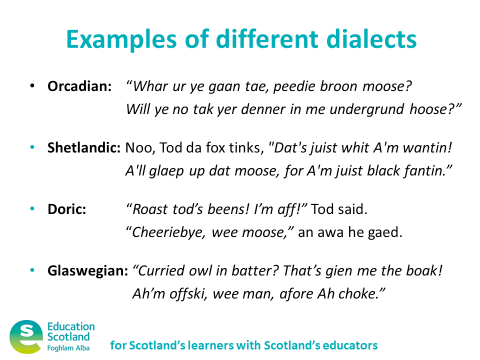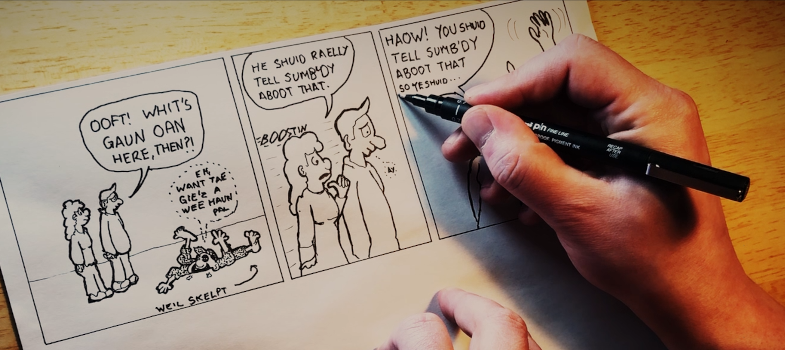Scots as a language learning option in schools

© Michael Dempster
2. Input
2.3. Activity 4
As writing a language forms an important part of the way we teach languages in educational contexts, you are going to explore written Scots in some more detail. In this activity, you will use examples to find out how the written Scots language evolved, and what particular features it developed, which made it the written Scots language we know today.
Michael
asks an important question in this part of his film, Hou
dae A best write sae thit fowk ken hou tae read oot whit it is that
A’m writin? To answer
Michael’s question, now engage with three input texts in parts A to
C which will provide ideas of how a pupil will write in Scots and how
you can support them in developing their written Scots.
A.
To
start with, read a short summary of the development of written Scots
and take notes of any developments you may wish to discuss with
others on this course.
A historical excursion into the development of Scots
A useful distinction to be made when approaching Scots as a language is to consider it first of all as a spoken language, and that the written language is a complement to a spoken or a gestural language. Written Scots, as is the case with many written languages, is the representation of the spoken language using the technology of the alphabet largely developed to represent Latin.
Written Scots began in the 14th century along with other vernacular literatures such as Italian and Middle English. Foundational works in these languages are The Divine Comedy in Italian by Dante Aligheri completed in 1320, The Brus in Scots by John Barbour completed in 1375, and The Canterbury Tales in Middle English by Geoffrey Chaucer written between 1387 and 1400. One of the earliest works in Scots is Scotland after Alexander dated to circa 1300.
Written Scots has a continuity through the past 700 years to this day. It reflects changes in the spoken language over that period, as do the vernacular literatures of other spoken languages. All written languages have different influences and processes in their development and usage. When using written Scots in learning Scots as a language it can be useful to understand some of this when introducing a text.
Written Scots was used as a language of record, law, correspondence and literature until the 17th century. During this period conventions of grammar, lexicon and spelling emerged. In the late 17th through the 18th century written English was adopted as the language of record and law. During this period English became standardised and this was the model on which Scottish Standard English emerged as a spoken language.
From the 18th century Scots literature continued with an ideology of revivalism, retaining written Scots’ lexicon and spelling but increasingly becoming influenced by the grammar and spelling conventions of written English. It continued to develop reflecting the spoken language, however increasingly it represented the finer differences of Scots dialects and the innovation of the individual authors.
At various times in the history of the Scots language the adoption of pan-dialectical conventions, which are language principles used across the dialects of the Scots language, have been employed to support the revival and ensure the survival of the language (see 'Scottish language subordination and revitalisation in multilingual UK: Eye on Scots and UK education'). In these revitalisation endeavours, language conventions were often drawn more from historical literature rather than the spoken language. This has led to what has become known as Literary Scots, where, to a greater or lesser extent, each text stands not as a record of the spoken Scots language, but as a proposition of what Scots, written and spoken, ought to be.
This overview, 'Examples of written Scots through the history of the language', by Michael can help you and your pupils develop writing skills with examples of written Scots through the history of the language.
B.
You will now delve a little deeper into the story of how writing the Scots language on the page began, using materials on the Education Scotland website which were written by teachers in collaboration with scholars at Glasgow University. The resource is a series of lessons providing learners with an introduction to Medieval Britain and Scots language through activities based around Listening and Talking, Reading and Writing.
-
Go to ‘Engaging with spelling in Scots language’ and study the lesson ideas, with a specific focus on writing in Scots. You may find it helpful for this activity to look back at lessons you have delivered previously and adapt that lesson plan, rather than create a completely new one. Depending on the age of your class and/or the subject you teach, it may be best to add a Scots element or focus to a lesson you know already works well.
-
Begin to develop your own lesson idea for writing in Scots which you will bring to the tutorial and take notes in your learning log.
C.
Moving on from looking at the historical aspects of Scots, you will now explore Scots today and how this can feature in your classroom, leading on from your work in creative writing in Unit 5.
Take a note of key points in the input text below and end your engagement with Activity 4.C with Elaine C. Smith’s video and your teaching ideas around this.
Learning Scots as a living language
As a living spoken language one often finds that there is a wealth of linguistic knowledge to draw from Scots within the classroom. Usually, we experience Scots as spoken where we live and as it has not yet been codified (see Codification) it can be best to approach it from this perspective. It may be the case that the pupils have a greater linguistic knowledge of spoken Scots than the teacher, particularly in local dialectical usage. Be prepared to facilitate this. Depending on the age of your class there are a number of ways you can entice learners to share their knowledge of the language, be it sharing stories of community events, or within families, or even by presenting the class with objects or cultural artefacts – this is the approach taken in the Open University Scots Language and Culture course where a ‘handsel’ (see Learning the Scots Language) introduces each unit.
A further option is to use a well-known piece of literature which has been translated into Scots. Here are four examples of a translation of a children’s book into different Scots dialects. Each line is in a different dialect and all come from published translations of Julia Donaldson’s The Gruffalo.

© Education Scotland Examples of The Gruffalo in different Scots dialects
Here you can observe four different authors making different decisions on how to codify their Scots, but all four are going through the same process of mirroring on the page how the people in that area of the country would pronounce Scots, and which words or vocabulary is prominently used there. This approach to writing, used by published authors, is very popular in schools across Scotland. Embracing dialect diversity and pupils’ unique voice has been commended by bodies like Education Scotland and the SQA.
And when it comes to reading the Scots determined by different dialect influences, there are various techniques you can use to assist if you do not understand written Scots. To stick to the examples from The Gruffalo in Scots:
-
you have the original English text and knowledge of the story;
-
the fact that the story follows a rhythm and the lines rhyme in couplets;
-
context clues;
-
and resources such as the Dictionary of the Scots Language, both the full online version and the Scots Dictionary for Schools App.
Here are activities you can undertake with the resource in this activity.
-
Choose 4 lines from the Gruffalo in dialect, record yourself speaking them or translate them into English. Your pupils can try the same.
-
Watch 'Elaine C Smith reads The Glasgow Gruffalo' and pay attention to the way in which she uses rhythm and rhyme to pronounce the Scots language. *Please note: You can watch this video with subtitles/closed captions by activating this feature on the YouTube player

-
Depending on the age group and subject you are teaching, either
- take 4 lines from The Gruffalo in Scots and analyse how the poem’s structure helps with the pronunciation of Scots. You can find different versions of the text on the National Improvement Hub: The Gruffalo in Scots ;
- alternatively select a different text to work with, for example from the Scots poetry on the Scots Language Centre website.
Find out more about dialect variation and the development of Scots spelling conventions with resources developed by Michael.
